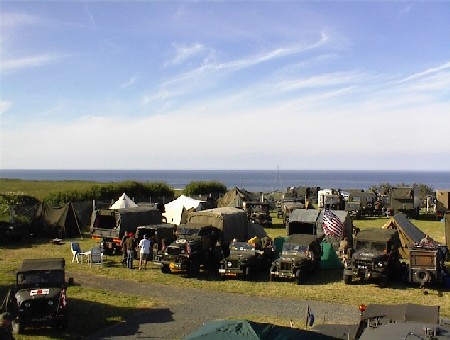
1-2 June
Greetings from Vierville-Sur-Mer, Omaha Beach! We (Andre PB0AJN and Kees PB0AIA) made it to Normandy in one piece. It was a two day drive, with a stopover in a camping in Marseille En B. We are here because Club Wheels, the classic green vehicles collector association, organised a trip to Normandy to join in the celebrations of the 60 year anniversary of D-Day. Andre and I did not want to miss this historical event, so we had to go! Andre did a lot of work preparing the Dodge for this enormous trip, and preparing the BC652/653 and BC348/191 radios, because they of course had to come along for the ride!
On 31 may we loaded the Dodge with the radios and all other stuff we would need. Because we would stay on a camping, things like a tent and all stuff that goes with that was needed too. And lots of technical stuff had to come along as well, like radios, antennas, generators, and a lot more. Fortunately Andre has a big Ben Hur type trailer to go along with the Dodge.
We started at five thirty in the morning of june 1 in Breugel. From there we drove to the hotel on the highway near Gent in Belgium where the Wheels members would meet up. We were a bit late, because we had lost our way, so almost the moment that we were there, everybody left. After a while we caught up with the tail end of the convoy. We did have a very well made route description that Wheels made, so if we lost the convoy again we could follow the route anyay.
At this halfway stop we met up with Henk PA3ACC. We had invited him along for the trip because he is an expert at CW communication. He has been making morse qso's for 30 years now, so he is much better at it than us, and for qso's from the special location in Normandy we figured we needed an expert. Fortunately Henk was willing to join us in this adventure.
It was quite a challenge to drive the Dodge all this way. It was loaded heavily, and with a heavy trailer too, it had to work hard in the French hills. Fortunately Andre is an excellent driver.
At the halfway camping we erected an inverted V antenna and made contact with our friends back home. Our signal was so strong that they at first didnt want to believe that we actualy were in the north of France! Getting into contact wth home turned out to be easier via the radio than via a GSM phone. You have to make these pre-pay phones jump through hoops first before you can call internationally with them.
Around five on the second day we arrived in Viervilles. There were already so many other green vehicles there, and complete re-enactment camps, that it seemed the invasion of the Americans was still happening! It was great to see it all.
There are at least a hundred other green vehicles in the Vierville camping at the beach alone, and in other campings around here there are many more. A lot of events are planned for the coming week, visiting museums, historical sites and re-enactment groups is all on the agenda.
3 June
Today was a day of rest. We used it to get the radio sets out of the Dodge, so we could contact The Netherlands with original wartime equipment. (We already put up the antenna, and did have contact yesterday several times with excellent results, but that was with a modern set.) We also visited the beach. There just was an exhibition of wartime trucks and re-enacting soldiers from an Italian group, it was just like we were in the middle of the invasion. We looked out over the sea a bit, and up to the high cliffs, contemplating the many lives that were lost on that very spot. There was a beautiful sand sculpture made to remember the soldiers that lost their lives. We talked to one veteran, who had been an aviator in the war. He wanted to borrow a plastic bag from us so he could take home some of the sand of the Normandy beach.
In the afternoon we untangled the Dodge from the antenna cables and went for a drive along the coast, looking for a gas station and a supermarket. When you have no fridge, you have to go shopping every few days, and the Dodge was thirsty too. During the drive, we noticed that green monster drivers are like motorcyclists. They greet everyone that drives a green vehicle. In the villages, the people still wave enthousiastically, even tho they must have seen many other old green vehicles by now. A small group of young people even gave us an applause when we were driving along the beach in one village.

A small part of the camping. The Dodge is in the middle of this picture, nearly invisivble just to the left of a small white tent.
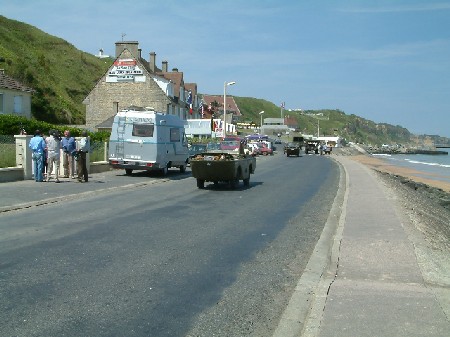
The hills and cliffs that the American soldiers had to climb in june 1944 under heavy fire.
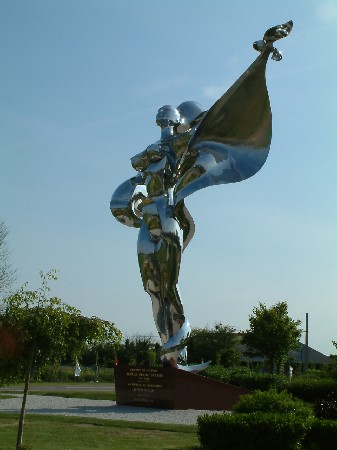
The "World Peace Statue": a beautiful sculpture by a Chinese artist commemorating 60 years of peace.
4 june
Today a drive through the American sector was on the program. First we visited St. Mere Eglise, where the paratroopers had such a hard time during the invasion. Today the city was invaded again. There were so much green vehicles, soldiers in original attire, tourists, and buses with the veterans, it was totally jammed. All the sights that were there to see had so many people around them, that we just gave up, and only had a cup of coffee there.
After that, we went to the large gun position in Azeville that had been used to defend the coast. It was a very big bunker complex that had taken two years to build. It was claustrofobic like a submarine inside, it was incredible that hundreds of men had lived in it.
For the final event of the day we went to Utah Beach, where there had been such a heavy fight. The bunkers are all still there. It was quite sobering to be actually there on the beach where so many men lost their lives.
And now I'm listening to two power generators working together to power the big BC191 transmitter while Henk and Andre are trying to contact the friends back home with the old transmitter operated in the way it used to be, in morse code.

Veterans in front of the church in St. Mere Eglise where the lone parachuter had been hanging all night
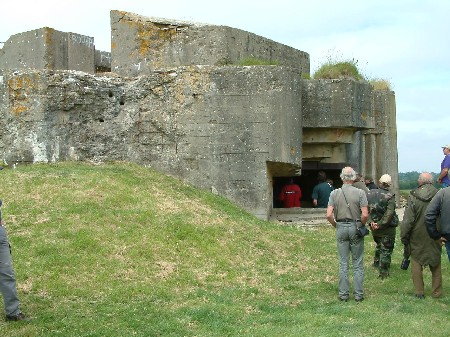
One of the Azeville bunkers still showing the traces of the heavy fire it sustained

The Dodge on Utah Beach! (Andre behind the wheel, and Kees next to the car)
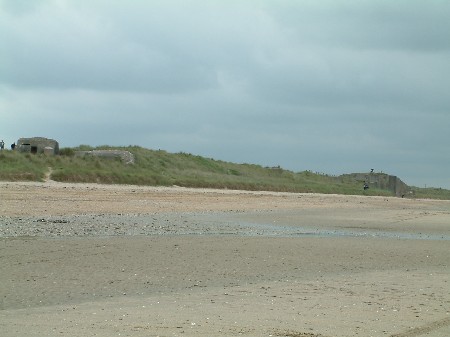
The bunkers on Utah Beach seen from the sea
5 june
Today we started up the radio set again and were active on 80 and 40 meters. Many morse contacts were made by Henk. On phone one memorable contact Andre had was with a special event D-Day station at the Dover Castle museum. They were very happy to make contact with Omaha Beach while they had many visitors, because they were using low power vintage equipment, the GRC-9.
This evening a Dutch big band, the Zendmasters, played many Glenn Miller-type jazz songs on the village square next to the beach. We also witnessed the official memorial ceremony honoring the members of the US National Guard that fell during the attack on Omaha beach. The evening was concluded with a massive fireworks, simultaneously launched from five beaches.
6 june
This morning we got out of bed very early to witness the memorial ceremony at the exact hour when 60 years ago the attack started. It was very cold and misty as it was then. It was a very impressive event. The rest of the day we operated the radios.
7 june
Today we went for a drive in the English sector. We saw the Battery at Longues. Four impressive guns that still were in their bunker system. Despite the fierce attack on the site it looked like it had only sustained minor damage. You could walk around in all bunkers safely. It was incredibly good weather, so many people were doing just that. It was very crowded at the site.
We also visited Tracy sur mer, from where you could see very well the remains of the giant caisson harbour the Americans had built in the sea to be able to unload all their supplys quickly.
For us radio amateurs the high point of the day was the radar station at Douvres. Of the five dishes that were used to spot aircraft, one had been restored. In the bunkers a set of displays explained how the system had worked.
At the end of the afternoon we payed our respects to the fallen soldiers at the cemetary at Colleville.
In the evening we started up the radios again. We had to fix a minor defect on the BC191, a wheel had come off a coil, so we couldnt tune the antenna any more. After that, some more contacts with The Netherlands and several other countries were made.

A gun at the battery of Longues
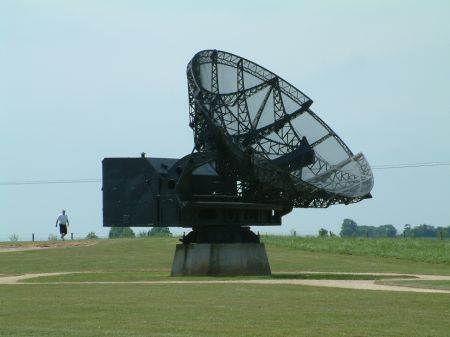
The radar dish that was restored
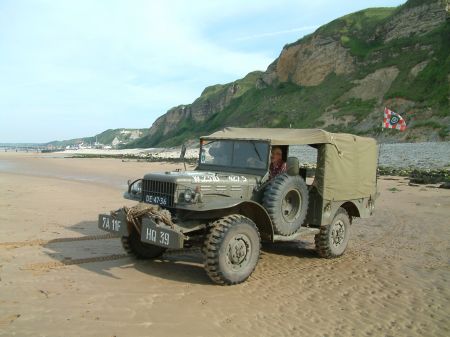
The Dodge on Omaha beach
8 june
Today we visited the Omaha beach museum in Vierville. It is close to the camping and we had passed it many times but only now we got around to entering it. It was a large diorama of many artifacts used during the war. It was a much better museum than the radar museum. Here you actually got to see the real things, instead of enlarged pages out of a book pasted against the walls.
We went back to the American funeral ground in Colleville. There is a giant monument there describing the war. On the back there are endless lists of names of the soldiers who fell and went missing. The funeral ground self is an endless field of white crosses, each one bearing a name of the soldier who died during the war. It was a warm and sunny day, and people were walking around over the graves, laughing and chatting. Some graves bore flowers, or had a small group of people quietly huddling around it. This really brings home the enormous amount of people that died during the second world war.
We visited Point du Hoc, the gun bunker complex on top of the very steep cliffs near to Grandchamps. It was like walking on the moon, so many craters still were there from the bombardment the site had sustained. Fences were put up to keep the visitors away from the edges of the cliff, because it might cave in. There were many tourists again.
Now we are packing up. Tomorrow morning the trip home starts.
In all Henk made about 75 different CW contacts and Andre made about 25 different phone contacts.